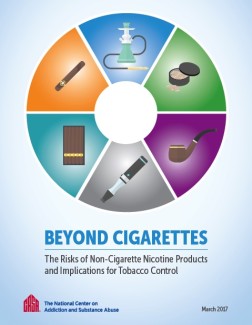Beyond Cigarettes: The Risks of Non-Cigarette Nicotine Products and Implications for Tobacco Control

BACKGROUND
Whereas much is known about the effects of tobacco use, the current state of knowledge regarding non-cigarette nicotine products, such as electronic nicotine delivery systems (e-cigarettes and other vaping devices), water pipe/hookah, smokeless tobacco, pipes, cigars, little cigars, and cigarillos, that do not contain tobacco is not robust enough to yield a definitive consensus regarding their relative risks and benefits.
METHODS
In this report, we review and summarize the available research on all non-nicotine products, describe the risk factors and consequences of use and the current regulatory landscape, discuss barriers to reducing use, and offer concrete recommendations for overcoming these barriers. To explore the prevalence and patterns of use of non-cigarette nicotine products, we present findings from an analysis of nationally representative data from the U.S. Centers for Disease Control and Prevention (CDC) on nicotine product use among middle and high school students (from 2014) and among adults, aged 18 and older (from 2013-2014).
RESULTS
The landscape of nicotine product use is changing. Fewer people in the U.S. are smoking cigarettes while more people, particularly youth, are using non-cigarette nicotine products. Highlights from the data analysis include:
- Prevalence: An estimated 16 percent of adults and 15 percent of middle and high school students reported current use of at least one non-cigarette nicotine product.
- Most Commonly Used Nicotine Products: The most commonly used nicotine products among adults, after cigarettes (18 percent), were cigars (7 percent) and e-cigarettes (7 percent). Among middle and high school students, they were e-cigarettes (9 percent) followed by water pipe/hookah (6 percent) and cigarettes (6 percent).
- Multiple Product Use: More than one-third (38 percent) of adults and half (50 percent) of middle and high school students who reported current use of cigarettes or non-cigarette nicotine products indicated that they used more than one product. Among current users of nicotine products, 8 percent of adults and 20 percent of students said they used more than one non-cigarette product. The use of multiple nicotine products elevates the risks of nicotine addiction, alcohol and other drug use, and other harmful consequences.
- Nicotine Addiction: An estimated 5 percent of adults who reported using only non-cigarette nicotine products (and not cigarettes) in the past 30 days met criteria for nicotine addiction. More than half of adults and half of middle and high school students who only used non-cigarette nicotine products reported at least one symptom of nicotine addiction.
RECOMMENDATIONS AND CONCLUSIONS
A science-based approach to the regulation of all nicotine-containing products is required. This report features an extensive set of research-based recommendations directed towards policymakers, health care providers, and researchers looking to ensure that their response to non-cigarette nicotine products is effective, scientifically sound, and appropriately cautious in terms of balancing the need to reduce tobacco use while ensuring that a new generation of young people are not getting hooked on nicotine.